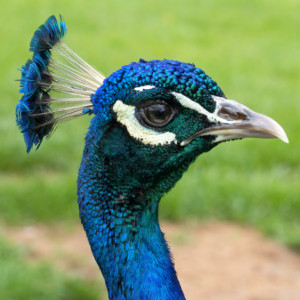Mountain Melick
Our first visit today was Bedford Purlieus NNR. We arrived at the site in glorious sunshine, and immediately made our way to the small colony of flowering Fly Orchid present near the edge of the grassland area in The Bedlams. Although the individual flowers are beautiful, the plants are remarkably easy to overlook, and it took us a few moments to find them. We found several other interesting species in this general area, including some fine flowering Early Purple-orchid, native Columbine (which was not quite in bloom) and a population of Hairy Lady’s-mantle.
A longish circular walk through the ancient woodland, negotiating the sometimes muddy rides, allowed us to compare the flora associated with the differing soil types. Areas of more-or-less neutral soil supported sheets of flowering Bluebell interspersed with the white flowers of Wood Anemone and the yellowish-green flowers of Wood Spurge. We found several interesting plants on the more acid soils including Hairy Woodrush, Greater Woodrush and Pill Sedge. The botanical highlights of the acid areas were sheets of Lily-of-the-valley, which was flowering nicely, and a small population of Hard Fern whose unfurling croziers were remarkably beautiful. The more base-rich areas of the site were dominated by Dog’s Mercury but we also found a clump of Mountain Melick which has very graceful nodding flowers. As the name suggests, this species has a northern distribution in the UK, being associated with base-rich rocks in northern England, and the population at Bedford Purlieus is close to its southern limit.
We arrived back at the coach at lunch time and made the short trip to Sacrewell Farm where we were able to buy coffee to accompany our packed lunches. By this time the clouds had bubbled up, and we could see showers in the distance, but fortunately we managed to avoid them for the rest of the day. Our lunch was gate-crashed by a very bold and magnificent peacock (see extra).
The afternoon was spent at Old Sulehay NR. We spent the first part of our visit in Stonepit Close, admiring the very species-rich grassland sward, which has a wide variety of annual plants including Little Mouse-ear , Parsley-piert, Early-flowering Forget-me-not, Field Madder and Small-flowered Buttercup. Spells of sunshine brought out several Dingy and Grizzled Skippers.
We then headed towards Old Sulehay Forest, stopping to admire a fine Wild Service-tree on our way, as well as many bushes of Spurge-laurel, a species which has spread locally as a result of the warmer, wetter winters associated with climate change. We spotted a couple of flowering Twayblade on the wide, managed margins of the Main Ride, and then turned into Mucky Ride, where the population of Herb-paris was at the peak of flowering. Our route through this wonderful ancient woodland took us through sheets of flowering Ramsons and Bluebell, past some spectacular pollarded Field Maple on the wood boundary and through an area known as the King’s Oaks, where we saw ancient coppice stools of Pedunculate Oak and Small-leaved Lime, now grown to massive proportions. We also saw a single fruiting spike of Toothwort, a rather ghostly-looking parasite which lives on the roots of coppiced Hazel and Field Maple.
We finally arrived back at the coach at 5 o’clock, but fortunately it was only a ten minute drive to the hotel where hot drinks and warm baths awaited the travellers.


Comments
Sign in or get an account to comment.


